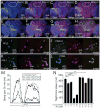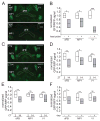Two dopaminergic neurons signal to the dorsal fan-shaped body to promote wakefulness in Drosophila
- PMID: 23022067
- PMCID: PMC3505250
- DOI: 10.1016/j.cub.2012.09.008
Two dopaminergic neurons signal to the dorsal fan-shaped body to promote wakefulness in Drosophila
Abstract
Background: The neuronal circuitry underlying sleep is poorly understood. Although dopamine (DA) is thought to play a key role in sleep/wake regulation, the identities of the individual DA neurons and their downstream targets required for this process are unknown.
Results: Here, we identify a DA neuron in each PPL1 cluster that promotes wakefulness in Drosophila. Imaging data suggest that the activity of these neurons is increased during wakefulness, consistent with a role in promoting arousal. Strikingly, these neurons project to the dorsal fan-shaped body, which has previously been shown to promote sleep. The reduced sleep caused by activation of DA neurons can be blocked by loss of DopR, and restoration of DopR expression in the fan-shaped body can rescue the wake-promoting effects of DA in a DopR mutant background.
Conclusions: These experiments define a novel arousal circuit at the single-cell level. Because the dorsal fan-shaped body promotes sleep, these data provide a key link between wake and sleep circuits. Furthermore, these findings suggest that inhibition of sleep centers via monoaminergic signaling is an evolutionarily conserved mechanism to promote arousal.
Copyright © 2012 Elsevier Ltd. All rights reserved.
Figures






References
-
- Tanaka C, Ishikawa M, Shimada S. Histochemical mapping of catecholaminergic neurons and their ascending fiber pathways in the rhesus monkey brain. Brain Res Bull. 1982;9:255–270. - PubMed
-
- Hendricks JC, Finn SM, Panckeri KA, Chavkin J, Williams JA, Sehgal A, Pack AI. Rest in Drosophila is a sleep-like state. Neuron. 2000;25:129–138. - PubMed
-
- Shaw PJ, Cirelli C, Greenspan RJ, Tononi G. Correlates of sleep and waking in Drosophila melanogaster. Science. 2000;287:1834–1837. - PubMed
-
- Cirelli C, Bushey D, Hill S, Huber R, Kreber R, Ganetzky B, Tononi G. Reduced sleep in Drosophila Shaker mutants. Nature. 2005;434:1087–1092. - PubMed
Publication types
MeSH terms
Substances
Grants and funding
LinkOut - more resources
Full Text Sources
Molecular Biology Databases

